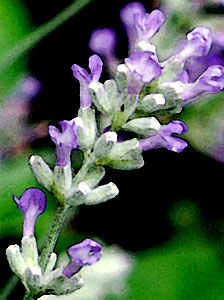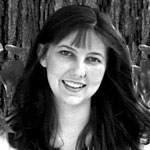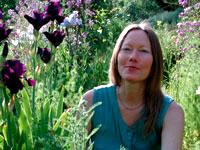Sensitive People
The biggest question sensitive people have is; 'why' are they so sensitive, why do they react so differently to the world than the 'average' person?
In her book, "The Sensitive Person's Survival Guide", Dr. Kyra Mesich very effectively tackles that question. Based on her personal experiences, she discovered the Yarrow flower essences to be crucial components in dealing with her, and others', sensitivity as a result of empathic ability.
 In trying to understand how Yarrow works, and works so well, Dr.Mesich thought back to the time before she began using flower essences. She was trained in aromatherapy and herbalism, so it was back to the roots of herbalism she went to see how Yarrow works. It's easy to "see" herbal Yarrow; it was the remedy used for ages and ages for "wounded warriors" suffering from deep cuts "down to the bone" (Yarrow has several common names and is also known as Soldier's Wound Wort and Knight's Milfoil.)
In trying to understand how Yarrow works, and works so well, Dr.Mesich thought back to the time before she began using flower essences. She was trained in aromatherapy and herbalism, so it was back to the roots of herbalism she went to see how Yarrow works. It's easy to "see" herbal Yarrow; it was the remedy used for ages and ages for "wounded warriors" suffering from deep cuts "down to the bone" (Yarrow has several common names and is also known as Soldier's Wound Wort and Knight's Milfoil.)
As Yarrow literally stops bleeding and "knits" the skin together, in the case of a sensitive person, it stops the bleeding/merging of the aura—into the surrounding emotional environment—and knits it back together. Yarrow is a master, an amazing helper, and like herbs in general, "causes what it cures, and cures what it causes". One folk name for Yarrow is "Nose Bleed" (another is "Staunchweed"); so while it can cause bleeding, it can also stop bleeding, and therefore we can say, it "regulates" bleeding. It can break up clots, thin the blood, but it also acts astringently and stops bleeding. (Dr. Mesich recommends "The Book of Herbal Wisdom" by Matthew Wood, to learn more about the herbal uses of Yarrow.)
The aura is similar to the body's circulation system —the aura circulates energy.
All people have been wounded by living in our callous, overly-focused-on-money, overly-intellectual, alienating, stimulus-overloaded world. For some people it causes a lot of "bleeding", and for others the result is stagnation; they become hardened. So Yarrow helps circulate the energy.
Dr. Mesich feels the different types of Yarrow correspond to the different chakras. "Plants are wise and give us clues", she says.
 |
| Pink Yarrow Photo by J.Sherry |
Pink Yarrow corresponds to the "root" chakra, the red chakra. It imparts a sense of strong groundedness. Pink Yarrow people don't have a good, confident sense of self, so look to complete themselves in relationship to other people. This results in imbalanced relationships where they "give too much" and try to solve other peoples' problems. As they begin to learn about flower essences, Pink Yarrow people identify themselves very quickly. In her workshops, Dr. Mesich often witnesses these people having a type of "epiphany". These people work hard to solve people's problems so that they themselves don't have to feel other people's pain. People who resonate with Pink Yarrow often have grown up in chaotic or abusive families without support, and could never develop a confident sense of self. Pink Yarrow also somewhat relates to the heart chakra in terms of giving oneself away to others.
 |
| Golden Yarrow Photo by Richard Katz of FES |
Golden Yarrow corresponds to the solar plexus chakra, the chakra involved in self-protection and it's also the communication link for all the other chakras. Golden Yarrow people are working as hard as they can to put up protection; they may be types who withdraw from the world, are timid, shy, or they may be the type of person who is cold or suspicious. They are more likely to use drugs, alcohol or cigarettes to put up boundaries between themselves and the emotional pain they feel as empathics—they are grasping at straws trying to protect themselves.
Dr. Mesich uses the example of a woman who, when she had to go to a grocery store, would wear music headphones, and shop as fast as she could, just to get in and out as quickly as possible. "Whew," she says, "that's no way to live."
 |
| White Yarrow Photo by J.Sherry |
White Yarrow is similar to white light, which contains all the colors of the spectrum. It relates to all the chakras and it's why it is a more "multi-purpose" remedy. It's for people who have all descriptions of sensitivity or are not sure what direction their sensitivity takes. In addition, White Yarrow is the general remedy for the age and time we live in, it addresses more than the personal sensitivities previously mentioned.
Yarrow Environmental Solution (formerly known as Yarrow Special Formula) is a remedy for a different purpose: it works well specifically for protection against invading energy, such as radiation. The other Yarrows help prevent the "bleeding out" of energy.
Yarrow is the remedy of the wounded warrior, but these days it's the remedy for the "wounded healer", for healing the wounded healer.
When referring to healers here, we are not only speaking of people such as nurses, doctors, and health practitioners, but of teachers, lawyers, counselors—all people who try to impact other people in a positive way.
The reason Dr. Mesich wrote "The Sensitive Person's Survival Guide", relates to her own experiences as a "wounded healer", as a professional counselor. She went through all her extensive training to become a clinical psychologist and received absolutely no information, or even a glimpse, of the energetic manifestation of emotions. She was trained to have clear boundaries between patients and her personal life, but came to realize these were just physical and intellectual boundaries, and they were meaningless without an understanding of energetic boundaries. She feels this oversight desperately needs to be addressed. At the same time, she knew she couldn't be the only one with these sensitivities—this empathic ability—it had to apply to everybody. Professionals receive intense training in their specific field of work, but there's a huge lack of understanding of empathy and sensitivity. With that knowledge and understanding, professionals could perform without being drained and personally hurt. They would be able to give from a more "grounded center" and help their clients more effectively.
Dr. Mesich feels that meditation practice and psychic development training also help to develop the tools that are needed by the souls of sensitive/empathic persons. If people choose to continue to live "bluntly", without developing on a soul level, certainly they will have to make compromises, she says. And Yarrow is the remedy for the "soul age"; it is calming for the soul. Further, she says, sensitive people are already so empathic, naturally empathic, they may as well learn how to use that empathic ability well.
Since writing the book, Dr. Mesich has been contacted by many people whoare physically and chemically sensitive individuals. This is driving her to think about, ponder, and speculate on the issues for people with physical sensitivity. Some are so sensitive, and have reacted so painfully to substances, they are even afraid to take flower essences. Dr. Mesich tells them they don't have to take it internally, but can use it in baths, carry it in their purses, or just sit with a bottle in the room with them, just "be" with the energy. As a professional, it's a very frustrating dilemma; on the one hand these types of people are so desperate for help, and on the other hand, they're not willing to try anything for fear of any resultant pain. In addition, by being wounded repeatedly, the aura may develop a syndrome, in addition to the physical syndrome.
Dr.Mesich likens this syndrome to the Chinese medicine concept of "reckless marauding of the blood" characterized by heat invading the body so deeply it is symptomized by fever, skin eruptions, and unclear thinking; so much "heat", sometimes, that blood vessels erupt and internal bleeding results.
In the situation we're speaking of here, the person experiences "reckless marauding of the aura"; the aura is not well-attached and can't give a good shield. What she is working on now is how this relates, and how it will help in the understanding of physical/chemical sensitivity. In the case of "recklessly marauding aura" one is not just fixing a hole, but must convince the aura to come back. In this case, Yarrow may work better than Yarrow Environmental Solution (formerly known as Yarrow Special Formula.)
When asked about her experiences with other essences, though she's used many, she says she is so "drawn" to Yarrow because it really targets the situations of need, while working across the spectrum of people who use it. However, there are other essences she recommends for sensitive people. She recommends Yarrow because she knows it will help and work. She does general education in her classes regarding flower essences, but then it's up to the individual to follow through with seeing a practitioner, or know for themselves what would be useful.
 |
| Goldenrod by Richard Katz of FES |
 |
| Lavender Painted Photo by J.Sherry |
Another essence she's used for sensitivity is Lavender, for "high strung" people, those who can't sleep well. In addition, Goldenrod is useful, but there are many other flower essences related to sensitivity issues as well.
The main point Dr. Mesich wishes to make is that sensitivity is an issue of our times, it touches all types of personalities, ages, economic levels—it crosses all boundaries. Sensitivity can result in anxiousness or depression. It really affects people broadly and that's why it's so confusing to the field of psychology and people in general.
Sensitivity is related so much to our whirling, moving, energetic auras, and that's what Yarrow can impact: it's something that can't be intellectually addressed. Sensitive people feel like something is wrong with them, that they're weak. "I'm trying to help people understand that it's simply a reaction to living in this world; one that's intellectual, bereft of information about soul and energy. It's our culture's lack of knowledge or awareness, (regarding sensitivity and empathy) not something that is personally wrong with us. The soul, our energy, is aware of that, but the intellect is not."
Afternote:
On September 11th, terrorists hijacked four airplanes and used them as live bombs to attack the World Trade Center in New York City, and the Pentagon in Washington, D.C. With these events in mind, Dr. Mesich wrote more about the issues discussed in this article; please visit her website to read more.
About Dr. Kyra Mesich
 Kyra Mesich earned her doctoral degree in clinical psychology from the Florida Institute of Technology’s APA-approved program in Melbourne, FL. In the years since her training, Dr. Mesich has studied extensively in the field of alternative health. By studying such practices as herbalism, flower essence therapy, energy healing, and meditation, Dr. Mesich seeks to uncover the true meaning and underlying source of the emotional suffering so many of us endure. Dr. Mesich is the author of the award-winning book, "The Sensitive Person’s Survival Guide". She works and resides in Minneapolis, Minnesota. Please visit Dr. Mesich's website.
Kyra Mesich earned her doctoral degree in clinical psychology from the Florida Institute of Technology’s APA-approved program in Melbourne, FL. In the years since her training, Dr. Mesich has studied extensively in the field of alternative health. By studying such practices as herbalism, flower essence therapy, energy healing, and meditation, Dr. Mesich seeks to uncover the true meaning and underlying source of the emotional suffering so many of us endure. Dr. Mesich is the author of the award-winning book, "The Sensitive Person’s Survival Guide". She works and resides in Minneapolis, Minnesota. Please visit Dr. Mesich's website.
Click here to link to an archived audio interview with Dr. Mesich aired on the Windows to Wellness radio talk show.
“People suffer in countless ways from their sensitivity, depression being the most common, and most are never properly diagnosed, only medicated. Reading The Sensitive Person’s Survival Guide gave me a ray of hope that the day is coming when the maladies of empathic people will be taken seriously and treated in a more realistic way.”— Echo Bodine, author of "Echoes of the Soul"
About "The Sensitive Person’s Survival Guide"
"The Sensitive Person’s Survival Guide" presents a radically new way of looking at emotional sensitivity and chronic depression and anxiety. Through her own experiences and courageous research, Dr. Mesich (a traditionally trained psychologist) has found that psychic sensitivity is the underlying key to understanding emotional sensitivity.
Dr. Mesich’s book focuses on empathic ability, the ability to literally feel other people’s emotional experiences, also known as psychic feeling. This misunderstood ability often results in recurrent depression, anxiety, and the painful aspects of emotional sensitivity due to our society’s denial and repression of the existence of psychic phenomena. With simple, down-to-earth language and case examples, Dr. Mesich demystifies empathic ability, and explains the relationship between emotional sensitivity and psychic sensitivity.
Readers also learn specific alternative health remedies and practices they can immediately implement in their own lives to rebalance their sensitivity and reconnect with their empathic ability. Armed with this knowledge, readers will experience relief from mysterious lifelong emotional suffering, and turn their sensitivity into a strength and a joy.
"The Sensitive Person’s Survival Guide" is available through Flower Essence Services.
About Jann Garitty
 As a Flower Essence Society staff member, Jann Garitty is involved with web design, class administration, writing, research and practitioner outreach. She has a wide variety of personal interests and commitments as a jeweler, gardener and herbalist. For over 30 years, she has worked with Native American organizations in education, arts, and cultural outreach and is the former Director of the Sierra Storytelling Festival. Jann is the mother of two grown children and lives in the Sierra Nevada foothills of northern California with her family and a menagerie of animal companions.
As a Flower Essence Society staff member, Jann Garitty is involved with web design, class administration, writing, research and practitioner outreach. She has a wide variety of personal interests and commitments as a jeweler, gardener and herbalist. For over 30 years, she has worked with Native American organizations in education, arts, and cultural outreach and is the former Director of the Sierra Storytelling Festival. Jann is the mother of two grown children and lives in the Sierra Nevada foothills of northern California with her family and a menagerie of animal companions.
(Photo of Dr. Mesich courtesy of Flower Essence Society. Photo of Jann Garitty courtesy of the author. Reprinted with the kind permission of Jann Garitty and the Flower Essence Society. See page two for information about FES)
The Flower Essence Society

“The Flower Essence Society (FES) is an international membership organization of health practitioners, researchers, students, and others interested in deepening knowledge of flower essence therapy. Originally founded in 1979 by Richard Katz, the society has been co-directed since 1980 by Patricia Kaminski and Richard Katz, who are married and professional partners.The Society promotes plant research and empirical clinical research on the therapeutic effects of flower essences, conducts training, certification programs, and seminars throughout the world as well as disseminating publications about flower essence and provides a communication & referral network for an estimated 50,000 active flower essence practitioners who are teaching, researching and practicing flower essence therapy in their healing work.”
The Flower Essence Society maintains a beautiful and informative website with an abundance of free research articles by & about practitioner research in the field and in depth case studies. You can make online donations at the website. You can also become a member in the society right online giving you access to an additional wealth of research essence profiles. Membership also includes access to the book, Flower Essence Repertory. The Repertory is a richly illustrated, cross referenced informative resource for anyone interested in Flower Essence therapies. Patricia and Richard also manage Flower Essence Services, which produces flower essences and herbal products at Terra Flora, their 17 acre biodynamic/organic garden and wildlife sanctuary in the northern Sierra Nevada foothills of Nevada City, California.
(Note: Jane Sherry & Curtis Lang, Satya Center Founders have been using the Flower Essence Services products for several years, and have found that they provide consistant, vital and exquisite flower essences and herbal products of a very high vibrational quality. They have a deep and profound effect personally and in their healing practice. FES very generously provides a discount for health practioners and their products are very affordable for the general public.
And, if you are interested in learning more about flower essences, reading up on groundbreaking research, flower profiles, flower affirmations, discounts on publications, practitioner referral network and member newsletters, I highly recommend investing a small amount of time and money in becoming a member of the Flower Essence Society. It costs only $25 per year, and is a valuable way to contribute your love and energy into healing yourself, your loved ones and our only home, Planet Earth.)
